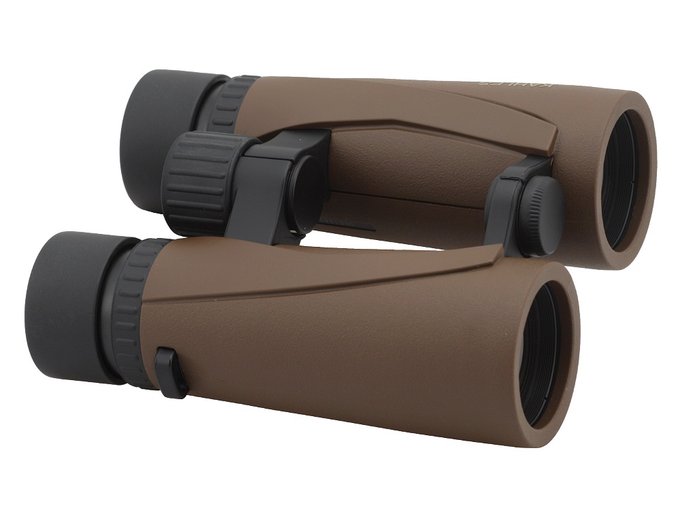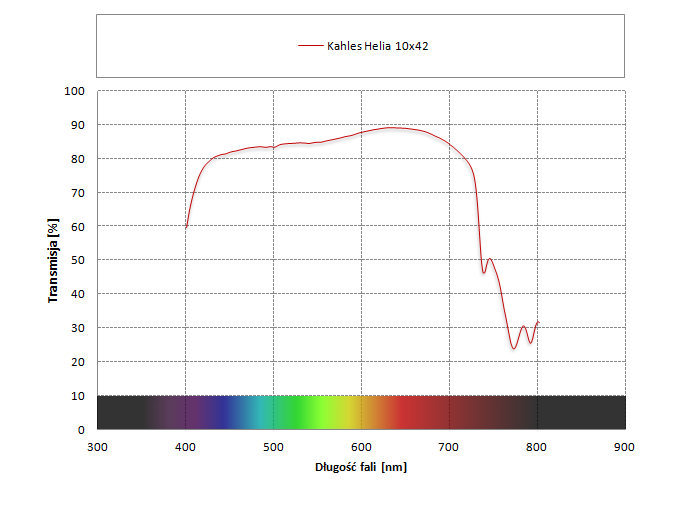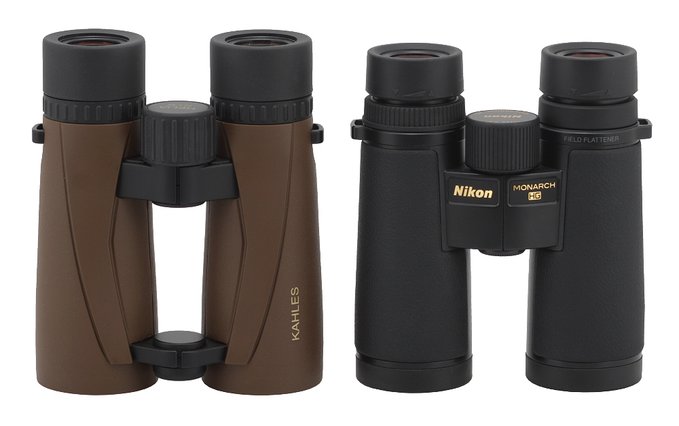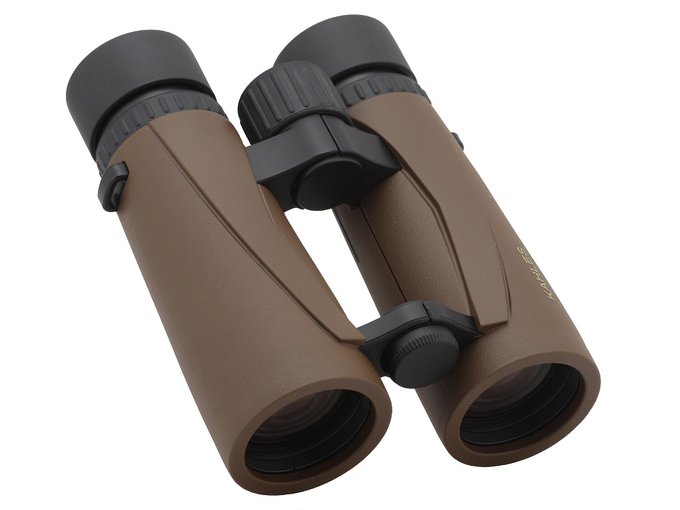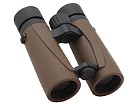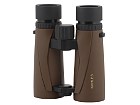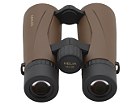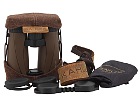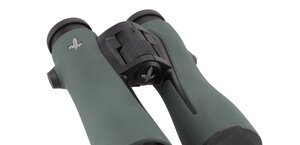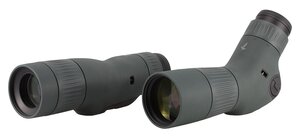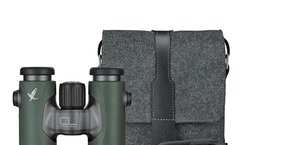Kahles, a company from Austria, so far have specialized mainly in riflescopes. Even though they have been present on the market for over one hundred years recently their binoculars line-up consisted of three roof models with the following parameters: 8x32, 8x42 and 10x42 for quite a long time.
2016 brought many changes. Older binoculars were withdrawn from the market and two new models called Helia, the 8x42 and the 10x42, were launched. Both these constructions are based on Schmidt- Pechan roof prisms.
It is difficult to find any detailed information concerning the type of glass and/or coatings on lenses and prisms either in the catalogue or on the producer’s site. Still the transmission is supposed to amount to 86.9% in the 8x42 model and to 86.5%, a bit more, in the 10x42 model. However Kahles does not say what wavelength they got the aforementioned results for.
Both pairs of binoculars are waterproof up to a depth of one meter and nitrogen filled. Buyers get objective caps which can be attached to the barrel, a rainguard, a solid neck strap, a soft pouch and a case-protection band for the objectives and eyepieces. The product comes with a 11-year guarantee period.
| Magnification |
Lens diameter |
Angular field of view |
Prisms |
Eye relief |
Weight |
Price |
| 10 |
42 |
114/1000(6.5o) |
BaK-4/roof |
20 mm |
770 g |
3890 PLN |
|
|
| Real front lens diameter |
Left: 42+/-
0.05 mm
Right: 42+/-
0.05 mm
|
8 / 8.0 pkt |
| Real magnification |
10.17+/-
0.1x
|
3/3.0 |
| Transmission |
84.9+/-
1%
|
12/25.0 |
| Chromatic aberration |
Noticeable in the centre but it would be difficult to call it high. Significant on the edge. |
5.2/10.0 |
| Astigmatism |
Excellent. Almost point-like star images. |
9.2/10.0 |
| Distortion |
The distance between the first curved line and the field centre compared to the field of view radius: 89% +\- 2% |
10/10.0 |
| Coma |
Occurs in a distance of 70% of the field of view radius and is medium on the very edge. |
7.3/10.0 |
| Blurring at the edge of the FOV |
Blur visible in a distance of 82% ± 2% from the field of view centre. |
6/10.0 |
| Darkening at the edge the FOV |
Slight. |
4/5.0 |
| Whiteness of the image |
Very delicate yellow-orange hue. |
4/5.0 |
| Collimation |
Perfect. |
5/5.0 |
| Internal reflections |
| Left: |
Right:
|
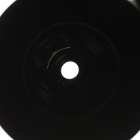 |
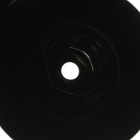 |
A slight, bright arch next to the pupil but, overall, the situation looks good. |
3.9/5.0 |
| Housing |
Shapely and stylish. The barrel covered by rubber armour which is rough but pleasant to the touch. It clings to the binoculars quite well, sticking out slightly near objective lenses but only when pressed. Thumb indentations. Comfortable to hold and to look through. Rubberized eyecups with three regulation stops. |
7.8/8.0 |
| Focusing |
Huge, rubberized central wheel covered by rubber. It moves smoothly, without any squelching, and is well-damped. A full turn requires an angle of 570 degrees.
Individual focusing done by a ring on the right eyepiece which is ribbed and covered by rubber. It moves smoothly and is well-damped but it moves the outer element.
|
4.5/5.0 |
| Tripod |
At the front of the binoculars. Far from the centre of mass. |
2/3.0 |
| Interpupilary distance |
from 55.5 to 73.4mm
|
4/6.0 |
| Closest focusing distance |
1.60 meters. |
2/2.0 |
| Eyepieces FOV |
Apparent field of view of 66.5 deg (according to simple formula) and 60.3 deg (according to tangent formula). |
14.5/20.0 |
| Field of view |
Measured by us amounted to 6.54 +/- 0.04 degrees and it was in perfect accordance with the specifications. A wide field for this class of equipment. |
7.5/8.0 |
| Quality of the interior of the barrels |
Black tubes but slightly shiny. Baffled very well. Dark and matt bottom but the prism binding, sticking from it, is made of gray metal, not covered by anything. Very clean inside, you see just isolated specks of dust. |
4/5.0 |
| Vignetting |
| Left: |
Right:
|
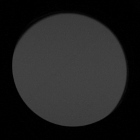 |
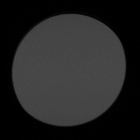 |
OL: 5.25%, OR: 7.95%
Distinctly truncated exit pupils. |
1/8.0 |
| Prisms quality |
High quality BaK-4. |
8/8.0 |
| Antireflection coatings |
Green-yellow on objective lenses, green on the prisms. Multicoloured on the eyepieces (green, purple, yellow, pink and blue). Low intensity. |
5/5.0 |
| Warranty [years] |
11 |
5/6.0 |
| Final result |
75.2%
|
142.9 / 190 pkt
|
| Econo result |
|
0pkt. |
Summary
Pros:
- very solid casing,
- wide field of view,
- sensible transmission,
- negligible astigmatism,
- invisible distortion,
- moderate coma,
- proper colour rendition,
- sharp image already from 1.6 of a meter,
- slight brightness loss on the edge of the field,
- good quality BaK-4 glass prisms,
- good quality antireflection coatings covering all air-to-glass surfaces,
- proper cleanliness and darkening inside the tubes.
Cons:
- distinctly turncated exit pupils,
- too high chromatic aberration on the edge of the field.
The Kahles company proved once again that they are able to produce a good pair of binoculars. The Helia 10x42 is a very solid instrument, meticulously assembled, with blameless optics. Its result was just several points short of outstanding and these points we deducted because of truncated exit pupils and weak chromatic aberration correction on the edge of the field of view. If you are to compare the Kahles to the best binoculars on the market you should also say that its transmission could have been a tad higher and the curve a little bit less slanted.
I don’t doubt that if you decide to buy the Kahles Helia 10x42 you’ll be satisfied with its performance. Still there is one big problem: fierce competition. In the 42 mm class there are plenty of binoculars with similar optics and mechanics efficacy. You don’t have to look far: the same distributor offers you also the Meopta Meostar B1 10x42 HD which result in our test was slightly higher and it is also a tad cheaper. The Zeiss Conquest HD can also compete with the Kahles successfully – it fared better in our tests and you have to pay for it just a tad more. Among cheaper pairs of binoculars which are as optically good as the Kahles are such instruments as the Olympus EXWP I, the Vortex Viper HD, the Bushnell Elite ED or the Vanguard Endeavor ED II.

